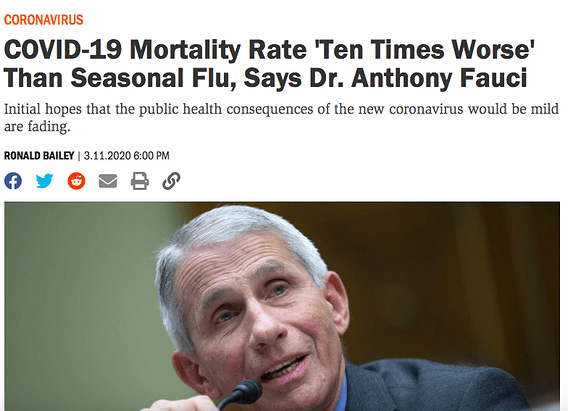The official WHO and CDC definitions are really enlightening, especially the difference between their public pronouncements and their actual positions. h/t Global Research
… The most recently discovered coronavirus causes coronavirus disease COVID-19.[Certificate Of Identity 2019?]
…
“COVID-19 is similar to SARS-1″: According to Dr. Wolfgang Wodarg, pneumonia is “regularly caused or accompanied by corona viruses”. Immunologists broadly confirm the CDC definition. COVID-19 has similar features to a seasonal influenza coupled with pneumonia.
According to Anthony Fauci (Head of NIAID), H. Clifford Lane and Robert R. Redfield (Head of CDC) in the New England Journal of Medicine [my highlights]
…the overall clinical consequences of Covid-19 may ultimately be more akin to those of a severe seasonal influenza (which has a case fatality rate of approximately 0.1%) or a pandemic influenza (similar to those in 1957 and 1968) rather than a disease similar to SARS or MERS, which have had case fatality rates of 9 to 10% and 36%, respectively.
Dr. Anthony Fauci is lying to himself. In his public statements he says that Covid is “Ten Times Worse than Seasonal Flu”.
He refutes his peer reviewed report quoted above. From the outset, Fauci has been instrumental in waging the fear and panic campaign across America:
Screenshot The Hill, March 19, 2020
Covid-19 versus Influenza (Flu) Virus A and Virus B (and subtypes)
Rarely mentioned by the media or the governments, The CDC confirms that Covid-19 is similar to Influenza:
“Influenza (Flu) and COVID-19 are both contagious respiratory illnesses, but they are caused by different viruses . COVID-19 is caused by infection with a new coronavirus (called SARS-CoV-2) and flu is caused by infection with influenza viruses. Because some of the symptoms of flu and COVID-19 are similar, it may be hard to tell the difference between them based on symptoms alone, and testing may be needed to help confirm a diagnosis. Flu and COVID-19 share many characteristics, but there are some key differences between the two.”
If the public had been informed and reassured that Covid is “similar to Influenza”, the fear campaign would have fallen flat.
The lockdown and closure of the national economy would have been rejected outright.
2. The Test for Covid-19 “Confirmed Cases”
The standard Covid test is the Reverse transcription polymerase chain reaction (RT-PCR ):
“The COVID-19 RT-PCR test is a real-time reverse transcription polymerase chain reaction (rRT-PCR) test for the qualitative detection of nucleic acid from SARS-CoV-2 in upper and lower respiratory specimens … collected from individuals suspected of COVID 19 … [as well as] from individuals without symptoms or other reasons to suspect COVID-19 infection. …
This test is also for use with individual nasal swab specimens that are self-collected using the Pixel by LabCorp COVID-19 test home collection kit … The COVID-19 RT-PCR test is also for the qualitative detection of nucleic acid from the SARS-CoV-2 in pooled samples, using a matrix pooling strategy (FDA, LabCorp Laboratory Test Number: 139900)
First, it should be understood that the Covid-19 RT-PCR Test is similar to that used in relation to Influenza. This test is based on upper and lower respiratory specimens.
The criteria and guidelines confirmed by the CDC pertaining to “The CDC 2019-Novel Coronavirus (2019-nCoV) Diagnostic Panel” are as follows (Read carefully):
Results are for the identification of 2019-nCoV RNA. The 2019-nCoV RNA is generally detectable in upper and lower respiratory specimens during infection. Positive results are indicative of active infection with 2019-nCoV but do not rule out bacterial infection or co-infection with other viruses [my italics]. The agent detected may not be the definite cause of disease. Laboratories within the United States and its territories are required to report all positive results to the appropriate public health authorities.
Negative results do not preclude 2019-nCoV infection and should not be used as the sole basis for treatment or other patient management decisions . Negative results must be combined with clinical observations, patient history, and epidemiological information.
What this suggests is that a positive infection could be the result of other viruses as well as other corona viruses. (i.e. related to seasonal influenza or pneumonia).
And, according to the CDC it “does not rule out “bacterial infection or co-infection with other viruses. The agent detected may not be the definite cause of disease.” (CDC)

